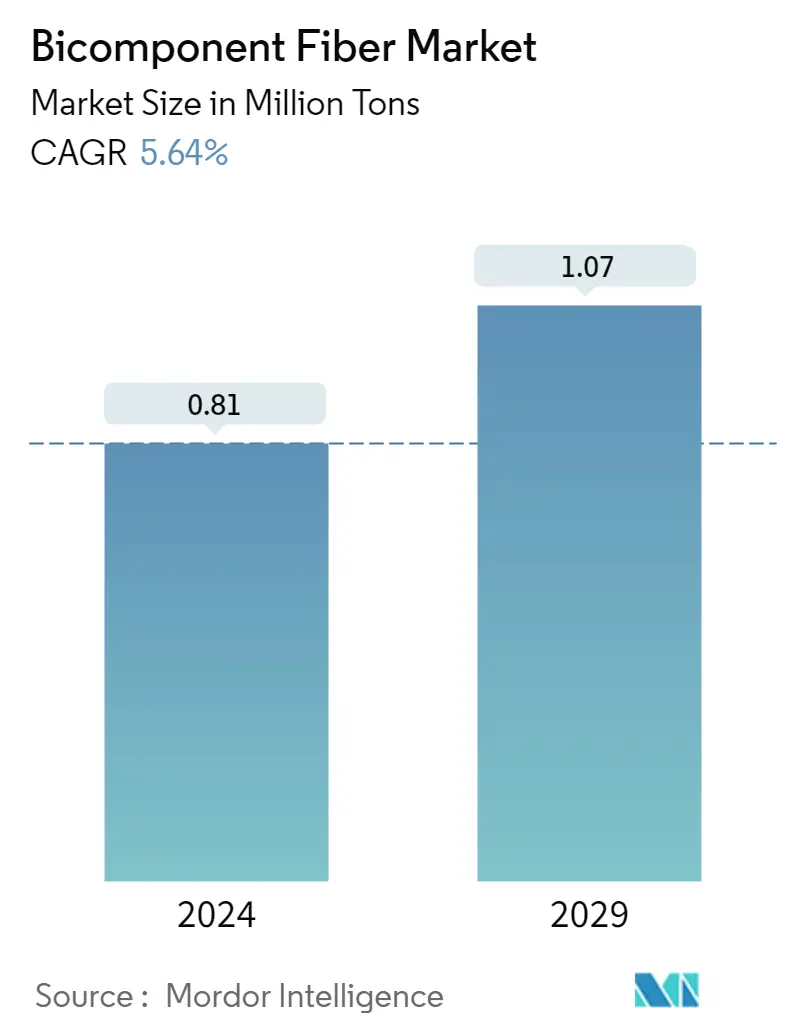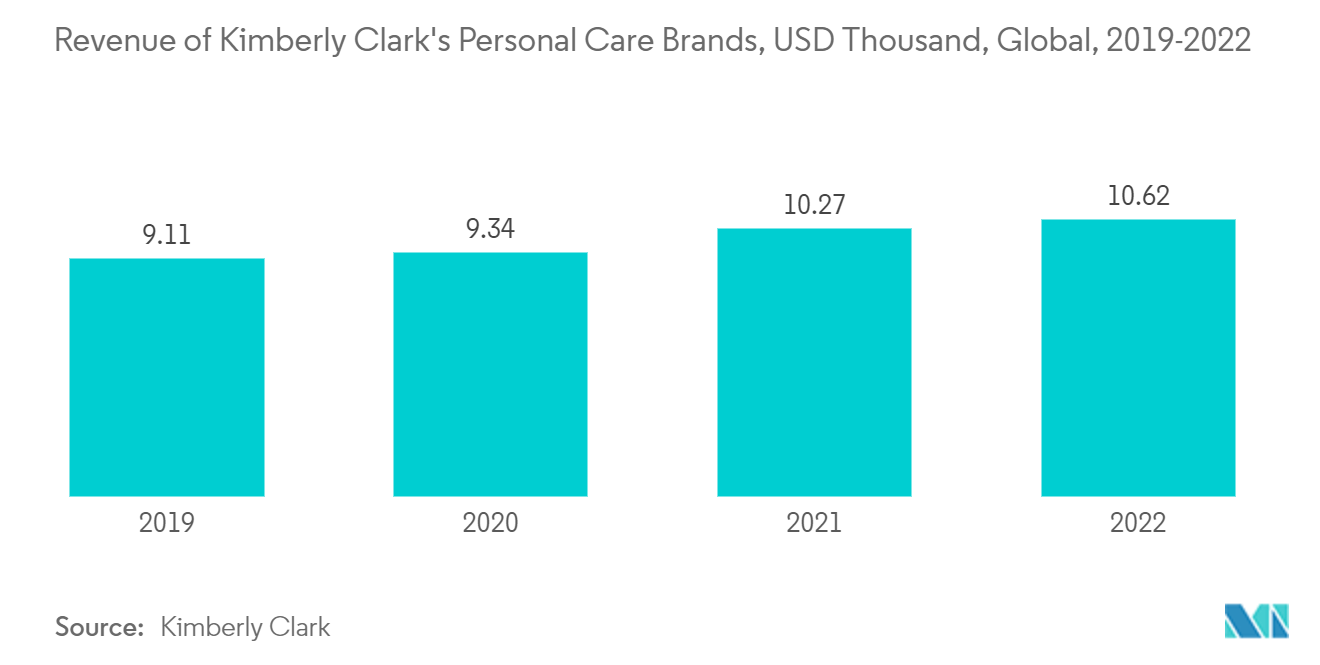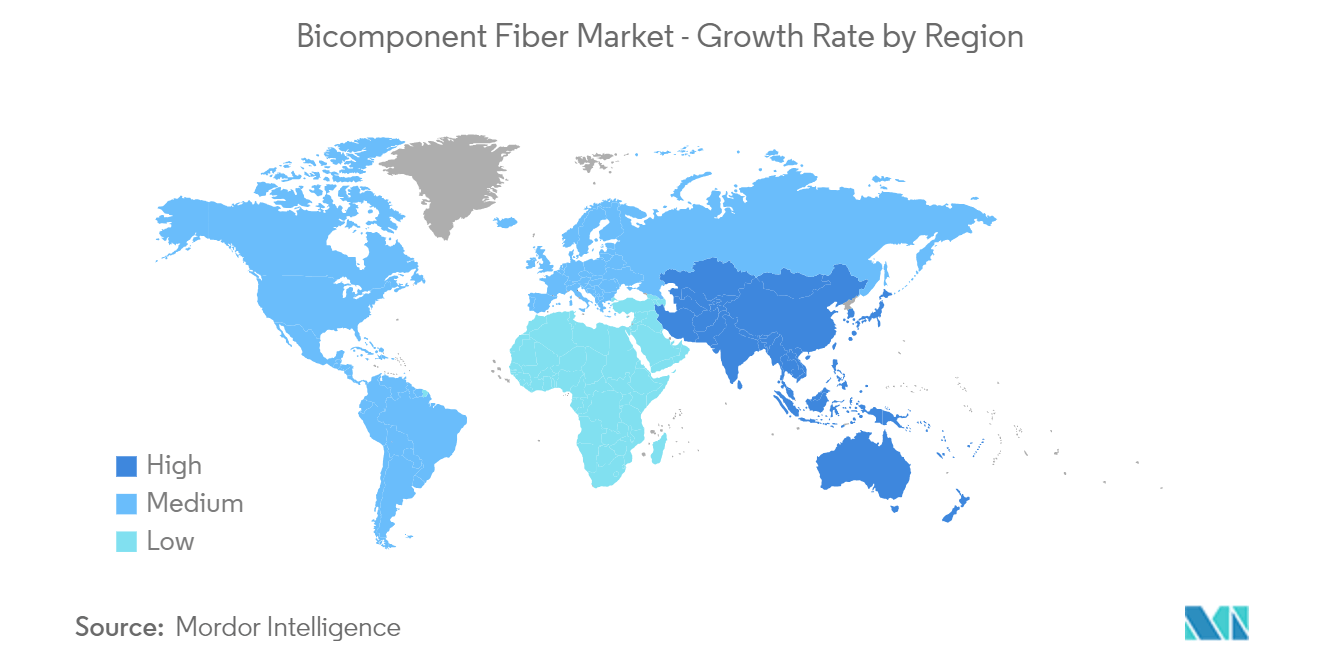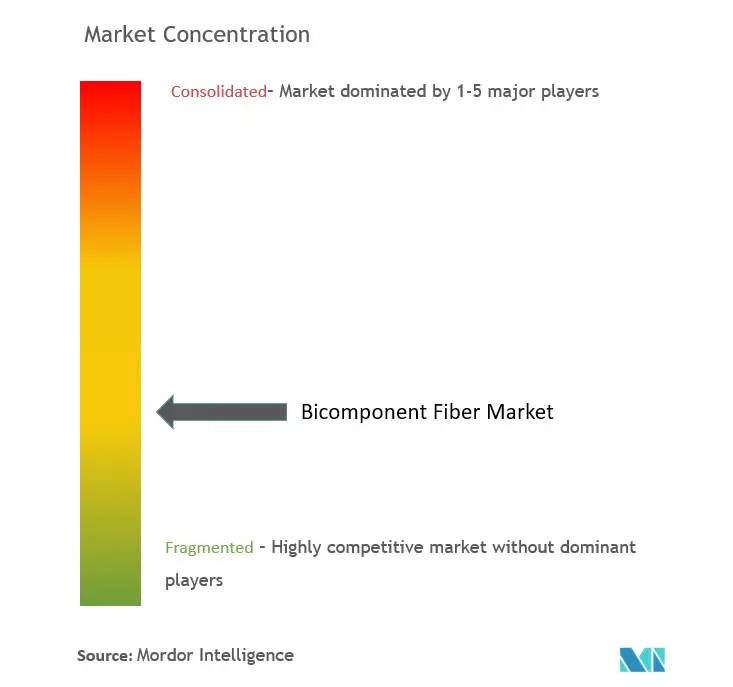Bicomponent Fiber Market Size

| Study Period | 2019 - 2029 |
| Base Year For Estimation | 2023 |
| CAGR (2024 - 2029) | 5.64 % |
| Fastest Growing Market | Asia Pacific |
| Largest Market | Asia Pacific |
| Market Concentration | Medium |
Major Players
*Disclaimer: Major Players sorted in no particular order |
Bicomponent Fiber Market Analysis
The Bicomponent Fiber Market size is estimated at 0.81 Million tons in 2024, and is expected to reach 1.07 Million tons by 2029, growing at a CAGR of 5.64% during the forecast period (2024-2029).
The COVID-19 pandemic, on a global scale, forced automakers, hygiene, medical, and non-woven textile products manufacturers to shut down their operations, lowering the demand for bicomponent fiber in 2022. The pandemic impacted almost every aspect of these industries, from product demand to workforce development to accelerating or decelerating trends already underway when it struck. Customers and their temporary production stops reduced production levels, and demand reductions significantly impacted production processes. However, the condition is expected to recover, restoring the growth trajectory of the market studied during the latter half of the forecast period.
- In the long term, the growing adoption of bicomponent fiber in the hygiene industry and rising demand from the non-woven textile industry are expected to drive market demand.
- Lack of consumer awareness and high production cost is expected to hinder the market's growth.
- Nevertheless, future applications of recycled bicomponent fibers is expected to offer lucrative opportunities to the market.
- Asia-Pacific accounted for the highest market share, and the region is likely to dominate the market during the forecast period.
Bicomponent Fiber Market Trends
Hygiene Industry to Dominate the Market
- Bicomponent fibers are utilized to produce nonwoven fabrics with a soft touch, along with other unique physical and aesthetic properties, which are deemed essential for diapers and hygiene products.
- These fibers are also used due to their versatile properties of being clean, recyclable, and have a uniform distribution of adhesive. These fiber nonwovens are the material of choice for products such as toddler training pants, infant diapers, feminine care products, adult incontinence products, medical underpads, wound care, and absorbent bandages, among others.
- Furthermore, owing to the increasing awareness about infant hygiene, parents are strongly adopting the usage of baby diapers and baby wipes. Diapers are among the essential infant daily care products, and baby wipes help prevent bacterial infection and provide comfort.
- According to the Parenting Mode company, the global disposable diaper market accounted for approximately USD 71 billion/year by 2022. Babies use about 6,000 diapers during their first two years of life. In addition, the personal care brands of Kimberly Clark, which include baby hygiene products, generated a revenue of USD 10.62 thousand in 2022 as compared to USD 10.27 Thousand in 2021.
- In April 2023, Millie Moon baby diapers announced their launch in Canada. Millie Moon claims to be a clean, luxury diaper brand offering high-performance and beautifully crafted diapers and sensitive wipes at affordable prices. The company also claims that the materials in its Luxury Diapers are extremely soft on babies' skin and engineered with CloudTouch Softness for optimum comfort.
- In March 2022, as part of its expansion plans in Nigeria, Kimberly-Clark opened a new manufacturing facility in Ikorodu, Lagos, which will manufacture Huggies baby diapers as well as Kotex feminine care products. With the investment of USD 100 million in its new state-of-the-art manufacturing facility, the company is equipped with the latest technology to serve its customers better.
- According to EDANA, in 2022, hygiene and personal care wipes accounted for more than 45% of all nonwoven use across Europe.
- Therefore, considering the growth trends and various projects of hygiene products in different regions worldwide, the hygiene industry is likely to dominate the market, which, in turn, is expected to enhance the demand for bicomponent fiber during the forecast period.

Asia-Pacific to Dominate the Market
- The Asia-Pacific region dominated the bicomponent fiber market in 2022, with a considerable volume and revenue share, and is expected to maintain its dominance during the forecast period.
- In the global textile and clothing market segment, China has always been a major player for the last two decades. Since becoming a member of the World Trade Organization, China's textile and clothing manufacturing and sales have increased dramatically, largely due to increased business from the West.
- According to the China Nonwovens and Industrial Textiles Association, the output of nonwovens in China was 8.14 million tons Y-o-Y in 2022. In addition, China continues to be an attractive market for selling athletic apparel, accessories, and footwear.
- The rising production of automobiles in China is likely to enhance the consumption of automotive textiles, which is expected to further support the demand for the studied market. According to the China Association of Automobile Manufacturers (CAAM), China produced 27,021 thousand units of automobiles in 2022, registering a growth rate of 3.4% compared to the previous year. Out of the automobile production in 2022, passenger cars accounted for 23,836 thousand units, whereas commercial car production accounted for 3,185 thousand units.
- Bicomponent fiber is used for insulation and flooring underlayment in the construction industry. The construction sector is key to China's continued economic development. China is amid a construction mega-boom. According to the National Bureau of Statistics of China, The value of construction output accounted for 31.2 trillion yuan (USD 4.5 trillion) in 2022, up from 29.3 trillion yuan (USD 4.2 trillion) in 2021, China is expected to spend nearly USD 13 trillion on buildings by 2030, creating a positive outlook for the studied market.
- Several diaper manufacturing companies in India are focusing on product innovation and expansion, which is further likely to drive the demand for bicomponent fibers. For instance, in January 2023, Kimberly-Clark announced the relaunch of its iconic diaper brand, Huggies, with the new ‘Huggies Complete Comfort’ range in India.
- In 2023, Reliance Retail's Performax activewear became the official kit sponsor for the Indian football team. The homegrown sportswear brand will have the exclusive rights to manufacture kits across all formats of the game. The firm will also be the sole supplier for all matches, travel, and training wear for the AIFF (All India Football Federation), including men's, women’s, and youth teams. In addition to this, as the merchandise sponsor, Performax is also expected to hold the rights to manufacture and retail these products.
- Hence, the reasons mentioned above are likely to fuel the growth of the bicomponent fiber market in Asia-Pacific over the forecast period.

Bicomponent Fiber Industry Overview
The bicomponent fiber market is partially fragmented, with several companies operating on both global and regional levels. Some of the major players in the market (Not in any particular order) include Indorama Ventures Public Company Limited, Far Eastern New Century Corporation, JNC Corporation, KURARAY CO., LTD., and TORAY INDUSTRIES, INC., among others.
Bicomponent Fiber Market Leaders
-
Indorama Ventures Public Company Limited
-
Far Eastern New Century Corporation
-
JNC Corporation
-
KURARAY CO., LTD.
-
TORAY INDUSTRIES, INC.
*Disclaimer: Major Players sorted in no particular order

Bicomponent Fiber Market News
- October 2022: Teijin Frontier Co. Ltd, a subsidiary company of Teijin Limited, opened a new manufacturing facility for the highly efficient production of polyester filaments. The company invested JPY 1 million (USD 0.01 million) in constructing this facility, and it is expected to produce 1,500 tons of polyester filaments, including bicomponent fiber, annually by the end of the year 2024.
Bicomponent Fiber Market Report - Table of Contents
1. INTRODUCTION
- 1.1 Study Assumptions
- 1.2 Scope of the Study
2. RESEARCH METHODOLOGY
3. EXECUTIVE SUMMARY
4. MARKET DYNAMICS
-
4.1 Drivers
- 4.1.1 Growing Adoption of Bicomponent Fiber In the Hygiene Industry
- 4.1.2 Rising Demand From the Non-woven Textile Industry
-
4.2 Restraints
- 4.2.1 Lack of Consumer Awareness and High Production Cost
- 4.3 Industry Value-Chain Analysis
-
4.4 Porter's Five Forces Analysis
- 4.4.1 Bargaining Power of Suppliers
- 4.4.2 Bargaining Power of Buyers
- 4.4.3 Threat of New Entrants
- 4.4.4 Threat of Substitute Products and Services
- 4.4.5 Degree of Competition
5. MARKET SEGMENTATION (Market Size in Volume and Revenue)
-
5.1 Material
- 5.1.1 Polyethylene (PE)/Polypropylene (PP)
- 5.1.2 Polypropylene (PP)/polyethylene Terephthalate (PET)
- 5.1.3 High-density Polyethylene/Low-density Polyethylene
- 5.1.4 Polyethylene/polyethylene Terephthalate (pet)
- 5.1.5 Polyester/PBT
- 5.1.6 Other Materials
-
5.2 Structure Types
- 5.2.1 Sheath-core
- 5.2.2 Side-by-Side
- 5.2.3 Islands in the Sea
- 5.2.4 Other Structure Types
-
5.3 End-user Industry
- 5.3.1 Non-Woven Textiles
- 5.3.2 Automotive
- 5.3.3 Hygiene
- 5.3.4 Construction
- 5.3.5 Medical
- 5.3.6 Other End-user Industries
-
5.4 Geography
- 5.4.1 Asia-Pacific
- 5.4.1.1 China
- 5.4.1.2 India
- 5.4.1.3 Japan
- 5.4.1.4 South Korea
- 5.4.1.5 Rest of Asia-Pacific
- 5.4.2 North America
- 5.4.2.1 United States
- 5.4.2.2 Canada
- 5.4.2.3 Mexico
- 5.4.3 Europe
- 5.4.3.1 Germany
- 5.4.3.2 United Kingdom
- 5.4.3.3 Italy
- 5.4.3.4 France
- 5.4.3.5 Rest of Europe
- 5.4.4 South America
- 5.4.4.1 Brazil
- 5.4.4.2 Argentina
- 5.4.4.3 Rest of South America
- 5.4.5 Middle-East and Africa
- 5.4.5.1 Saudi Arabia
- 5.4.5.2 South Africa
- 5.4.5.3 Rest of Middle-East and Africa
6. COMPETITIVE LANDSCAPE
- 6.1 Mergers and Acquisitions, Joint Ventures, Collaborations, and Agreements
- 6.2 Market Ranking Analysis
- 6.3 Strategies Adopted by Leading Players
-
6.4 Company Profiles
- 6.4.1 CHA Technologies Group
- 6.4.2 EMS-chemie Holding AG
- 6.4.3 Far Eastern New Century Corporation
- 6.4.4 Freudenberg Performance Materials
- 6.4.5 Huvis Corp.
- 6.4.6 Indorama Ventures Public Company Limited
- 6.4.7 JNC Corporation
- 6.4.8 Kolon Glotech
- 6.4.9 Kuraray Co. Ltd.
- 6.4.10 OC Oerlikon Management AG
- 6.4.11 PTT Global Chemical Public Company Limited
- 6.4.12 Shaoxing Yaolong Spunbonded Nonwoven Technology Co. Ltd
- 6.4.13 TEIJIN Limited
- 6.4.14 TORAY Industries Inc.
- 6.4.15 WPT Nonwovens Corp.
- *List Not Exhaustive
7. MARKET OPPORTUNITIES AND FUTURE TRENDS
- 7.1 Future Applications of Recycled Bicomponent Fibers
Bicomponent Fiber Industry Segmentation
Bicomponent fiber, or heterophil fiber, is a special class of synthetic fiber manufactured using two different polymers and then extruded as a single filament. This fiber combines the benefits of two polymers to obtain fibers with unique properties, such as effective thermal bonding, fine fibers, unique cross-section, easy customization, and others.
The bicomponent fiber market is segmented by material (Polyethylene (PE)/Polypropylene (PP), Polypropylene PP/Polyethylene Terephthalate (PET), high-density polyethylene/low-density polyethylene, polyester/polyethylene polyester/PBT, and other materials), structure types (shell-core, side-by-side, islands in the sea, and other structure types), end-user industry (non-woven textiles, automotive, hygiene, construction, medical, and other end-user industries), and geography (Asia-Pacific, North America, Europe, South America, and Middle East & Africa).
The report offers market size and forecasts for bicomponent fiber in terms of volume (tons) and revenue (USD) for all the above segments.
| Material | Polyethylene (PE)/Polypropylene (PP) | |
| Polypropylene (PP)/polyethylene Terephthalate (PET) | ||
| High-density Polyethylene/Low-density Polyethylene | ||
| Polyethylene/polyethylene Terephthalate (pet) | ||
| Polyester/PBT | ||
| Other Materials | ||
| Structure Types | Sheath-core | |
| Side-by-Side | ||
| Islands in the Sea | ||
| Other Structure Types | ||
| End-user Industry | Non-Woven Textiles | |
| Automotive | ||
| Hygiene | ||
| Construction | ||
| Medical | ||
| Other End-user Industries | ||
| Geography | Asia-Pacific | China |
| India | ||
| Japan | ||
| South Korea | ||
| Rest of Asia-Pacific | ||
| Geography | North America | United States |
| Canada | ||
| Mexico | ||
| Geography | Europe | Germany |
| United Kingdom | ||
| Italy | ||
| France | ||
| Rest of Europe | ||
| Geography | South America | Brazil |
| Argentina | ||
| Rest of South America | ||
| Geography | Middle-East and Africa | Saudi Arabia |
| South Africa | ||
| Rest of Middle-East and Africa |
Bicomponent Fiber Market Research Faqs
How big is the Bicomponent Fiber Market?
The Bicomponent Fiber Market size is expected to reach 0.81 million tons in 2024 and grow at a CAGR of 5.64% to reach 1.07 million tons by 2029.
What is the current Bicomponent Fiber Market size?
In 2024, the Bicomponent Fiber Market size is expected to reach 0.81 million tons.
Who are the key players in Bicomponent Fiber Market?
Indorama Ventures Public Company Limited, Far Eastern New Century Corporation, JNC Corporation, KURARAY CO., LTD. and TORAY INDUSTRIES, INC. are the major companies operating in the Bicomponent Fiber Market.
Which is the fastest growing region in Bicomponent Fiber Market?
Asia Pacific is estimated to grow at the highest CAGR over the forecast period (2024-2029).
Which region has the biggest share in Bicomponent Fiber Market?
In 2024, the Asia Pacific accounts for the largest market share in Bicomponent Fiber Market.
What years does this Bicomponent Fiber Market cover, and what was the market size in 2023?
In 2023, the Bicomponent Fiber Market size was estimated at 0.77 million tons. The report covers the Bicomponent Fiber Market historical market size for years: 2019, 2020, 2021, 2022 and 2023. The report also forecasts the Bicomponent Fiber Market size for years: 2024, 2025, 2026, 2027, 2028 and 2029.
Bicomponent Fiber Industry Report
Statistics for the 2024 Bicomponent Fiber market share, size and revenue growth rate, created by Mordor Intelligence™ Industry Reports. Bicomponent Fiber analysis includes a market forecast outlook to for 2024 to (2024to2029 and historical overview. Get a sample of this industry analysis as a free report PDF download.



